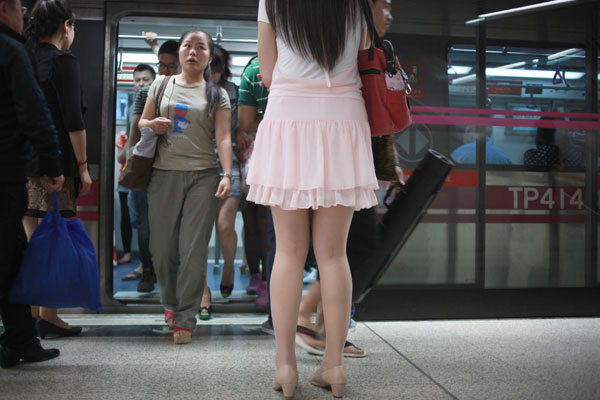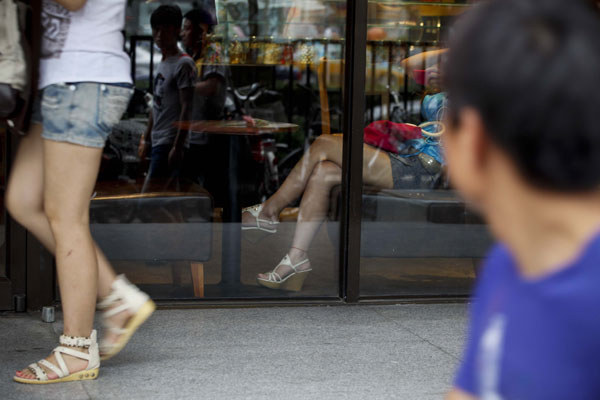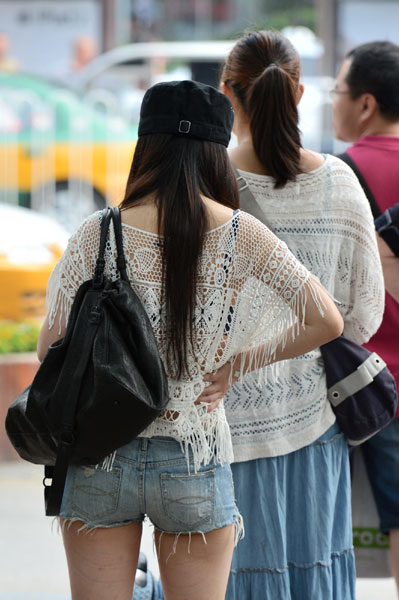Practical or provocative?
Updated: 2012-07-13 09:20
By Hu Yongqi, Wu Wencong and Tang Yue (China Daily)
|
||||||||
A storm has erupted after Shanghai subway bosses urged women to 'dress modestly' to avoid sexual harassment. Hu Yongqi, Wu Wencong and Tang Yue report.
Kan Chunling, 55, has always considered herself a follower of fashion and the most open-minded of her peers. However, she finds it hard to appreciate the revealing dresses worn by young women nowadays, but doesn't believe it's a result of a "conservative mind-set".
"The dresses and skirts sold in shopping malls today are just so short, so short," she said. "I can't help worrying about the young women who wear them - don't they feel insecure when they travel on crowded buses and subway trains? If not, on a purely practical level, don't they find those clothes inconvenient if they need to bend down or whatever?"
Kan was among the first batch of graduates after China's universities reopened in the wake of the "cultural revolution" (1966-76), majoring in English. In those days, even jeans were seen as inappropriate dress for most people because they were so tight-fitting. However, Kan's experience of foreign literature and culture meant she took it all in her stride.
 |
|
A young woman waits for her train at a subway station in Beijing. The company that runs the Shanghai Metro posted a notice on its official micro blog urging female passengers to dress modestly to avoid sexual harassment and warning that "many perverts" use the subway system. Wang Jing / China Daily |
 |
|
A woman sits in a cafe in Beijing. A growing number of women prefer to wear thinner, cooler and sometimes provocative clothes in China's sweltering summer season, sparking a debate on whether a more relaxed attitude toward styles of dress makes sexual harassment understandable. Kuang Linhua / China Daily |
 |
|
Women in Sanlitun, a popular area in Beijing, which contains many bars and international stores. Wei Xiaohao / China Daily |
Growing tolerance
"Those who wore jeans split into two groups at that time," recalled Kan. "One group saw jeans as a bizarre form of dress and wore them out of curiosity, really. The others really appreciated jeans and wore them as fashion items."
Even the early 1980s were free and easy compared with 20 years before. In the 1960s, Kan's mother-in-law was publicly criticized for wearing a purple skirt. The problem was not the style or length of the skirt, but simply the color. In those days, the only acceptable colors were olive green, navy blue, black, white or gray.
Many people have expressed amazement at the growing tolerance of skimpy dresses over the past 30 years. A video posted on Sohu, a Chinese Web portal, on Wednesday showed a woman in Shijiazhuang, the capital of Hebei province, riding on a bus wearing just a swimming costume. The other passengers were intrigued, but certainly not hostile.
In China's sweltering summer season, it makes sense for people to wear thinner, cooler clothes. However, the debate over scantily clad women really came to the fore when the company that runs the Shanghai Metro posted a notice on its official micro blog urging female passengers to dress modestly to avoid sexual harassment and warning that "many perverts" use the subway system. The notice set off a storm of protests on China's social networking sites as women criticized the company for apparently suggesting that they, and not the men who harassed them, were the guilty parties.
Wang Yichen, 27, who works for a British company in Beijing, said her parents have never protested about her style of dress. She says she is pretty open-minded and her only firm rule is that clothes must not be transparent.

 Relief reaches isolated village
Relief reaches isolated village
 Rainfall poses new threats to quake-hit region
Rainfall poses new threats to quake-hit region
 Funerals begin for Boston bombing victims
Funerals begin for Boston bombing victims
 Quake takeaway from China's Air Force
Quake takeaway from China's Air Force
 Obama celebrates young inventors at science fair
Obama celebrates young inventors at science fair
 Earth Day marked around the world
Earth Day marked around the world
 Volunteer team helping students find sense of normalcy
Volunteer team helping students find sense of normalcy
 Ethnic groups quick to join rescue efforts
Ethnic groups quick to join rescue efforts
Most Viewed
Editor's Picks

|

|

|

|

|

|
Today's Top News
Health new priority for quake zone
Xi meets US top military officer
Japan's boats driven out of Diaoyu
China mulls online shopping legislation
Bird flu death toll rises to 22
Putin appoints new ambassador to China
Japanese ships blocked from Diaoyu Islands
Inspired by Guan, more Chinese pick up golf
US Weekly

|

|






